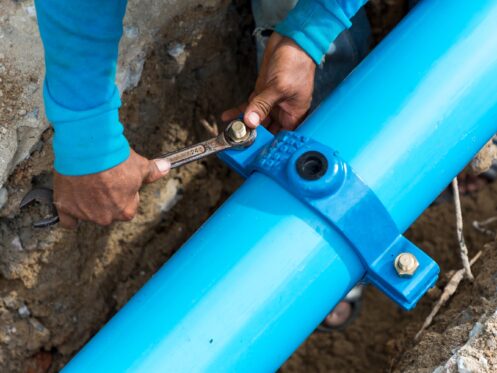The cost of repairing a sewage line may vary substantially depending on many different factors. Although these factors make it hard to discuss precise numbers, homeowners may anticipate and plan for associated costs by knowing what factors affect the price.
Midstate Plumbing & Air in Bridgeport, WV, provides homeowners plumbing, drain, and sewer services. Based on our experience, we’ve compiled this guide for homeowners experiencing sewer line problems. Read on to learn more about what a sewer line repair entails and what the total cost might be for your home.
Types of Sewer Line Issues
The most common sewer line problems include blockages, cracks, tree root intrusions, and complete collapses. Small blockages caused by waste buildup are often easier to fix. Cleaning the sewer line or hydro-jetting it can often resolve a small blockage.
However, more work may be necessary if tree roots have entered the line. Root problems are common in older homes because trees that are already old look for water and grow into small cracks in pipes over time. For this problem, it’s common for the roots to be cut out and any broken parts to be fixed.
More severe issues like pipe collapse or sewer line “bellies”—where part of the line sags, creating a pool for waste to accumulate—are the most complex to repair and require pipe replacement or significant restoration work. Determining the exact issue with a sewer line usually requires a professional inspection, often using a sewer camera.
Type of Sewer Line Material
The type of material used in the sewer line can significantly impact the cost of repairs. Sewer lines from older residences may be constructed of cast iron, clay, or even Orangeburg pipe, which is composed of compressed wood pulp and degrades with time. Each material has different repair requirements, durability levels, and difficulty associated with accessing or working with it.
While cast iron pipes may rust over time and cause leaks, clay pipes are more likely to fracture. PVC pipes, which are more common in newer homes, are generally more corrosion-resistant and often easier to repair. However, since different materials respond to wear and external factors differently, they can influence the repair process’s difficulty and cost. For instance, cast iron pipes may require specialized cutting tools to access, while PVC is more pliable and thus easier to work with.
Line Location and Acceessibility
Where the sewer line is located on the property and how accessible it is can heavily influence repair costs. If the sewer line is located close to the home’s foundation or even under it, reaching the line may require tunneling under the structure, which adds complexity and cost. Shallow sewer lines are easier to get to and don’t need to be dug up as much, which saves time. On the other hand, when lines are buried deep, much digging must be done.
Repair Method Chosen
One of the largest cost-determining factors is the method used to repair the sewer line. Traditional repair involves digging a trench to reach and fix the broken portion of the pipe. However, trenchless methods like pipe bursting or pipe lining are less invasive and may be more cost-effective in the long term.
Traditional dig-and-replace methods require excavation to reach the damaged area, which is labor-intensive and often involves additional costs for restoring landscaping or hardscaping once repairs are completed. In contrast, trenchless techniques, such as pipe lining and pipe bursting, can fix the issue without extensive digging.
Pipe bursting is the process of replacing an old, damaged pipe with a new one, eliminating the need for excavation. Both trenchless procedures are quicker, use fewer materials, and require less cleaning, potentially lowering expenses. However, they may still require some preliminary digging at the sewer line’s beginning and end, so the line’s condition and location will influence whether trenchless methods are an option.
Damage
The degree of damage to the sewer line plays a central role in determining repair costs. Minor repairs, such as fixing small cracks, are quicker and more straightforward, which keeps expenses down. However, if the line has multiple cracks, extensive root intrusion, or significant sagging, the work becomes more complex and time-consuming, driving up repair costs.
Permits and Regulations
Cities usually need permits to dig or fix things without digging. If repairs need to be done under a public road, additional permits for road access may also be required. This is especially true if the sewer line extends under sidewalks, driveways, or other areas that could impact public use.
Contact Us Today
While understanding what affects sewer line repair costs can help you prepare, consulting with a professional plumber is the best way to assess your situation accurately. Investing in routine sewer line maintenance and inspections can often help you avoid unexpected repairs, saving time and money in the long run. Midstate Plumbing & Air is ready to help with your sewer issues, drain cleaning, and all your other pipe and plumbing needs. We offer a wide range of plumbing solutions, including slab leak repairs, bathroom plumbing, water heaters, and more. Contact Midstate Plumbing & Air for a quote in Bridgeport.
